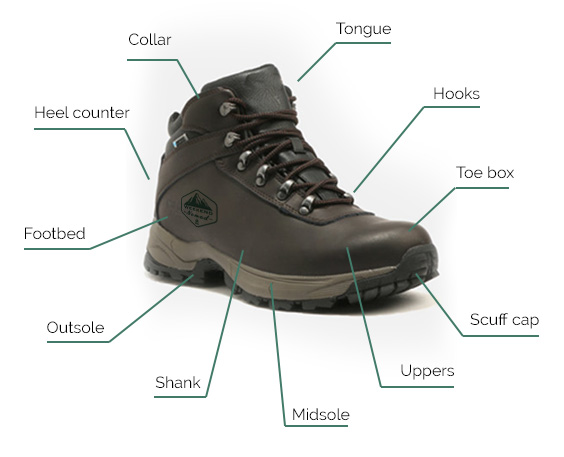The right shoes for your outdoor activity is very important. The good old hiking boot has evolved into a few different types of footwear that is suited to very different situations. Let's have a look.
.

Anatomy of a hiking boot
Collar
The collar is the padded bit that hugs your ankles and prevents them from rolling by giving added support
Heel counter
The heel counter is the molded cup that cradles your heel and increases support. A firm heel counter lock the foot into the boot and prevents the foot slipping inside the shoe.
Footbed
The footbed is a removable insole that can be replaced by a custom insert to suit the wearer.
Outsole
This is the outer sole of your boot. It's usually made from rubber and protects you foot from rough terrain and impact.
Shank
The shank is made from metal or strong nylon. It supports the arch of the foot and determines where the sole bends.
Midsole
The midsole is a cushioned layer that helps absorb impact and adds stability when walking on rough terrain.
Tongue
The tongue is a padded, flexible flap made from leather or fabric that adds padding to the top of the foot underneath the laces.
Hooks
Most hiking boots have hooks that ease the tightening and attaching of laces.
Uppers
The uppers is the skin of your boot. It is usually made from leather, canvas or GoreTex and gives shape to your boots. The uppers protect your feet and keep them in place.
Toe box
This is the solid box that protects your toes from impact while still allowing them to move.
Scuff cap
Some boots come with a strip of rubber on the front of the shoe that protects the toe box and the front of the uppers from impact.
Types of boots
Barefoot hiking shoes
|
Pros
|
Cons
|
- Very flexible
- Extremely light weight
- Dry very quickly
- More breathable the other shoes
- Can be worn during water sports
|
- Not suitable for cold conditions
- Very thin sole can get pierced by sharp objects easily
|
Trail Running shoes
|
Pros
|
Cons
|
- Quite flexible
- Lightweight
- Dry quickly
- More breathable than boots
|
- Not suitable for cold conditions
- Relatively expensive
- Not suitable for rough terrain
- Provides little support
|
Hiking boot
|
Pros
|
Cons
|
- Very sturdy
- Durable
- Offers a lot of protection against weather and rough terrain
- Offers support for feet and ankles
|
- Can be too warm in summer
- Heavy
|
Mountaineering boots
|
Pros
|
Cons
|
- Thick, heavy and sturdy
- Offers lots of protection against elements and terrain
- Ultimate support for feet and ankles
- Suitable for crampons
|
- Heavy
- Not comfortable to wear for long periods
|
Boot Maintenance
Cleaning
- Remove laces and insoles. These can be machine washed inside a washing bag.
- Brush off any dirt. Don’t do this while the dirt is still wet as you will only make it worse.
- Wash out any deep stains using special boot/shoe cleaner available in most camping shops. Alternatively you could dilute castile soap with water to clean your hiking boots using a rag or soft brush.
Drying
- Find as cool dry spot for your boots to dry. Never place your hiking boots next to a heater as the hot air will dry out the leather causing it to crack. Cracked leather can let in water.
- Stuff your boots with newspaper to soak up any sweat or water on the inside. This will speed up the drying process and prevent mould.
Removing mould
- Brush the mould off the boots. Do this outside and away from your face to prevent inhaling it.
- If you have stubborn mould, first wash your boots using the steps above.
- Mix one part water with one part vinegar and apply this to the areas affected by mould and let it dry.
- Keep mouldy boots away from other leather items to avoid contamination.
Waterproofing
- There are many waterproofing products on the market, but a simple jar of wax works very well.
- Using a rag, apply the wax generously concentrating on the seams as they are prone to leaking.